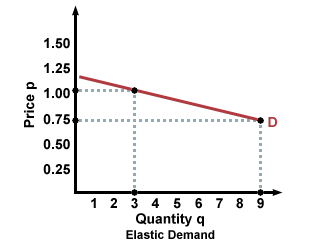We've already studied how supply and demand curves act together to determine market equilibrium, and how shifts in these two curves are reflected in prices and quantities consumed. Not all curves are the same, however: the steepness or flatness of a curve can greatly alter the effects of a curve shift.
Elasticity refers to the degree of responsiveness of the quantity demanded or supplied to changes in price. If demand is highly elastic, small changes in price will cause large changes in the quantity consumed. If demand is highly inelastic, then it will take large changes in price to effect even a small change in quantity consumed. Graphically, elasticity can be represented by the appearance of the supply or demand curve: the more elastic, the more horizontal; the more inelastic, the more vertical. When we are talking about elasticity, the term "flat" refers to curves that are horizontal; a "flatter" elastic curve is closer to perfectly horizontal.

At the extremes, the demand curve that represents perfectly inelastic demand is a vertical line, and the curve representing elastic demand a horizontal line. (Think of the vertical letter I, which stands for Inelastic, and the three horizontal lines in the letter E, which stands for Elastic.)

Consider the case in the figure below, where demand is very elastic, that is, the curve is almost flat. You can see that if the price changes from $0.75 to $1, the quantity demanded drops from 9 to 3. There are many possible reasons for this phenomenon. Buyers might be able to easily substitute away from the good, so that when the price increases, they have little tolerance for the price change. Maybe the buyers don't want the good that much, so a small change in price has a large effect on their demand for the good.

If demand is very inelastic, then large changes in price won't do very much to the quantity demanded. In the figure below, a price jump of a full dollar reduces the demand by just 2 units. Possible explanations for this situation could be that the good is an essential good that is not easily substituted for by other goods. That is, for a good with inelastic demand, customers really want or really need the good, and they can't get want that good offers from anywhere else. This means that consumers will need to buy more or less the same amount of the good from week to week, regardless of the price.

What causes demand to be more elastic for some goods than for others? Goods with very elastic demand tend to be non-necessary goods, or goods that can easily be substituted for by other goods. When the prices of these goods go up, consumers will either decide they don't really need the goods, and won't buy any, or they will begin to substitute away from the goods, buying more of the cheaper substitutes. One possible example of a non-essential good might be candy. It is not an essential good, and if the price were to double, demand would probably fall a good deal as consumers decide they don't really need to eat candy, especially since it costs so much money. An easily substituted good might be bottled water. If the price of one brand increases, demand will drop quickly as consumers decide to buy a competing brand, whose price has stayed the same.
Goods with very inelastic demand tend to be goods with no easy substitutes, or essential goods that consumers cannot do without. For these goods, even when the price increases, demand stays relatively steady, because consumers have no other options, and feel that they still need to buy the same amount of goods. In the short run, gasoline could be considered an inelastic good, since it is difficult to completely alter transportation patterns in an immediate response to changes in gasoline prices. (Over the long run, however, consumers may change their habits and decrease their consumption of gasoline, using public transportation or carpools, once they realize that their costs have increased permanently). Another example might be staple foods. While luxury items such as caviar or Belgian chocolates aren't essential to our diet, basics such as bread, pasta, and rice are relatively indispensable. In other words, an increase in price would have less effect on the consumption of staple foods than it would have on luxury foods.
We have been talking about the responsiveness of demand to changes in price—the price elasticity of demand, as it’s more properly called. More in-depth treatments of elasticity also cover the responsiveness of demand to changes in income, which is called the income elasticity of demand, and the responsiveness of the demand for one good to a change in the price of another good, which is called the cross-price elasticity of demand.
Like demand, supply also has varying degrees of responsiveness to price, which we refer to as the price elasticity of supply, or simply the elasticity of supply. When supply is inelastic (the supply curve is steep), the market will always supply very nearly the same quantity of goods, regardless of the price. When supply is elastic (the supply curve is flat), the quantity supplied will be dramatically affected by even small changes in price.













